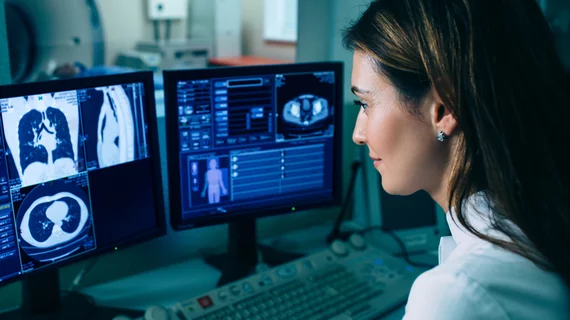Content-based AI system decreases read times by 31% while increasing accuracy
Integrating content-based image retrieval systems into clinical workflows could improve radiologists’ efficiency and accuracy, as was told by experts recently in European Radiology.
The July paper highlighted the benefits of content-based image retrieval systems (CBIRS) in radiology practices, revealing that radiologists who utilized them reduced their image interpretation times by an average of 31.3%.
The study, which took place in Austria, was centered specifically on the impact CBIRS had on interpretations of chest CT scans on patients with suspected diffuse parenchymal lung disease (DPLD). For the CBIRS assisted reads, radiologists would indicate regions of interest in CT images. The system would then review a database of 6,542 thin-section CT scans and populate a small set of the most likely diagnoses based on 19 lung-specific patterns in addition to providing supporting information.
In total, 108 scans were retrospectively analyzed. The scans contained 22 unique, clinically or histopathologically confirmed diagnoses and were interpreted by eight radiologists—four residents, four attendings. Half the scans were interpreted with CBIRS assistance, and half without.
“The main hypothesized advantage of the CBIRS is the streamlined provision of relevant information for the case the radiologist is currently reporting on,” corresponding author Helmut Prosch, from the Department of Biomedical Imaging and Image-guided Therapy at the Medical University of Vienna, and colleagues explained.
Using CBIRS decreased interpretation times despite the radiologists who utilized them having to review the additional information the system provided. Residents reduced their read times by an average of 27% and attending radiologists recorded a decrease of 35%. What’s more, CBIRS increased overall accuracy from 34.7% to 42.2%.
The authors noted that their results are of particular interest because other recent studies have implied that imaging exams that incorporate AI could actually increase workloads in some cases. Their contrasting findings are positive, but merit further research in larger clinical settings, the experts concluded.
More on improving radiology workflows:
SIIM 2022: 5 ways voice-triggered macros can improve radiologist workflow
VIDEO: What to look for in radiology workflow orchestration software
AI assists radiologists in detecting fractures, improves workflow
Reference:
Röhrich, S., Heidinger, B.H., Prayer, F. et al. Impact of a content-based image retrieval system on the interpretation of chest CTs of patients with diffuse parenchymal lung disease. European Radiology (2022).

